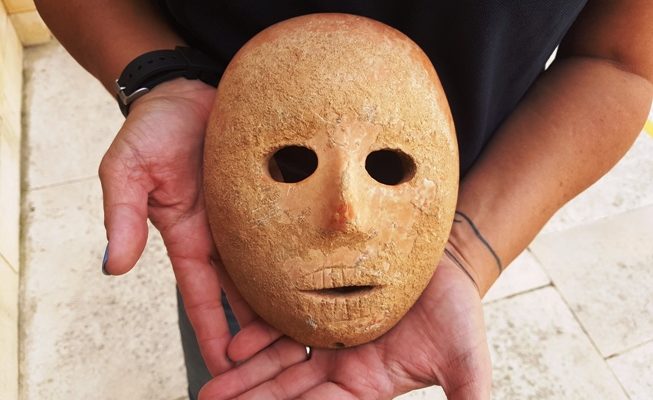A fascinating and rare 9,000-year-old stone mask that dates to the Neolithic period sheds new light on ancient life in the Holy Land.
By Aryeh Savir, World Israel News
Israeli archaeologists recently discovered a fascinating and rare 9,000-year-old stone mask that dates to the Neolithic (new stone age) period, one of only 15 in the world.
The mask was seized and recovered at the beginning of 2018 by the Israel Antiquities Authority’s (IAA) Theft Prevention Unit.
A subsequent investigation revealed that the mask was likely found at the archaeological site in the Pnei Hever region of southern Har Hebron.
Its characteristics, in addition to other findings from the contexts in which it was discovered, testify that the mask is 9,000 years old, dating to the Pre-Pottery Neolithic B period.
Ronit Lupu of the IAA’s Antiquities Theft Prevention Unit explained that “the mask is a unique finding in the archaeological world. It is even more unusual that we know which site it came from. The fact that we have information regarding the specific place in which it was discovered makes this mask more important than most other masks from this period that we currently know of.”
The mask is made of pinkish-yellow limestone, carefully shaped with stone tools to resemble a human face. Four holes were drilled along the perimeter of the mask, probably in order to tie it to a person’s face or possibly to a pole or another designated artifact where it could be displayed.
“Discovering a mask made of stone, at such a high level of finish, is very exciting,” Lupu stated. “The stone has been completely smoothed over and the features are perfect and symmetrical, even delineating cheekbones. It has an impressive nose and a mouth with distinct teeth.”
Links to the agricultural revolution
Dr. Omry Barzilai, head of the IAA Archaeological Research Department, said that “stone masks are linked to the agricultural revolution. The transition from an economy based on hunting and gathering to ancient agriculture and domestication of plants and animals was accompanied by a change in social structure and a sharp increase in ritual-religious activities.”
Ritual findings from this period include human-shaped figurines, plastered skulls, and stone masks. Ancestor worship was also practiced during this period.
“It was part of the ritual and retention of family heritage that was accepted at the time,” said Lupu. “For example, we find skulls buried under the floors of domestic houses, as well as various methods of shaping and caring for the skulls of the dead. This led to plastering skulls, shaping facial features, and even inserting shells for eyes.”
Stone masks, such as the one from Pnei Hever, are similar in size to the human face, which is why scholars tend to connect them with ancestor worship, she explained.
1 of 15 in the world
There are currently 15 known masks dating back to that period. Except for roughly two, there is no indication regarding the archaeological sites from where they originated.
The remaining masks are in private collections throughout the world, which makes them more difficult to study.
The importance of this newly discovered mask stems from the fact that it has been traced to an archaeological site that can be studied. The site could help researchers understand the culture in which the mask was produced.
Discovering the mask from Pnei Hever strengthens the assumption that the southern Hebron Hills area was a center for producing stone masks, most likely for ritual activities, in the Pre-Pottery Neolithic B period.




